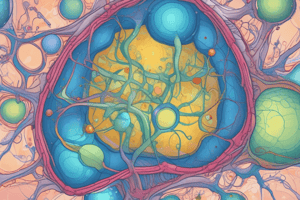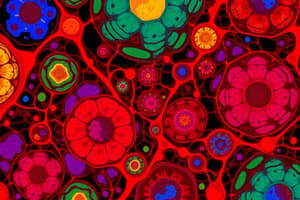Podcast
Questions and Answers
ما هو مجال التخصص للدكتور أحمد دغيدي؟
ما هو مجال التخصص للدكتور أحمد دغيدي؟
- علم النبات
- علم الكيمياء الحيوية
- علم البيئة
- علم الأحياء الجزيئي (correct)
في أي جامعة يعمل الدكتور أحمد دغيدي؟
في أي جامعة يعمل الدكتور أحمد دغيدي؟
- جامعة القاهرة
- جامعة العلمين الدولية (correct)
- جامعة الإسكندرية
- جامعة الأزهر
ما هو الرقم المرجعي للمحاضرة التي ألقاها الدكتور أحمد دغيدي؟
ما هو الرقم المرجعي للمحاضرة التي ألقاها الدكتور أحمد دغيدي؟
- BIO150
- BIO101
- BIO132 (correct)
- BIO200
ما هو أعلى درجة حصل عليها الدكتور أحمد دغيدي؟
ما هو أعلى درجة حصل عليها الدكتور أحمد دغيدي؟
ما هو موقع الجامعة التي يدرس بها الدكتور أحمد دغيدي؟
ما هو موقع الجامعة التي يدرس بها الدكتور أحمد دغيدي؟
ما هو الدور الذي تلعبه Sox2 و Oct4 في الخلايا الجذعية؟
ما هو الدور الذي تلعبه Sox2 و Oct4 في الخلايا الجذعية؟
ما هو التأثير الرئيسي لنشاط Sox2 و Oct4؟
ما هو التأثير الرئيسي لنشاط Sox2 و Oct4؟
أي من العوامل التالية يرتبط مباشرة بتفعيل Sox2 و Oct4؟
أي من العوامل التالية يرتبط مباشرة بتفعيل Sox2 و Oct4؟
أي من الخيارات التالية تعبر عن وظيفة Sox2 و Oct4 خارج إطار البلاستيكية؟
أي من الخيارات التالية تعبر عن وظيفة Sox2 و Oct4 خارج إطار البلاستيكية؟
ما هو الأثر المتوقع عند فقدان Sox2 و Oct4 في الخلايا الجذعية؟
ما هو الأثر المتوقع عند فقدان Sox2 و Oct4 في الخلايا الجذعية؟
Flashcards
BIO132
BIO132
أحد الأوراق البحثية التي نشرت في مجال علوم الأحياء الأساسية.
محاضرة 5
محاضرة 5
هو عنوان درس يحتوي على مادة علمية حول علوم الأحياء.
د. أحمد دغيدي
د. أحمد دغيدي
أستاذ جامعي في مجال علوم الأحياء الأساسية.
البيولوجيا الجزيئية
البيولوجيا الجزيئية
Signup and view all the flashcards
جامعة العلمين الدولية
جامعة العلمين الدولية
Signup and view all the flashcards
عامل النسخ Sox2
عامل النسخ Sox2
Signup and view all the flashcards
عامل النسخ Oct4
عامل النسخ Oct4
Signup and view all the flashcards
عامل النسخ Nanog
عامل النسخ Nanog
Signup and view all the flashcards
الخلايا الجذعية متعددة القدرات
الخلايا الجذعية متعددة القدرات
Signup and view all the flashcards
عملية التمايز
عملية التمايز
Signup and view all the flashcards
Study Notes
Introduction to Induced Pluripotent Stem Cells (iPSCs)
- iPSCs are a type of pluripotent stem cell, derived artificially from non-pluripotent cells (typically adult somatic cells).
- This process involves inducing "forced" expression of specific genes.
- They were first produced in 2006 from mouse cells and in 2007 from human cells.
Methods of Reprogramming Somatic Cells to iPSCs
- Somatic cell nuclear transfer (SCNT): Involves transferring the nucleus of a somatic cell into an enucleated egg cell.
- Cell fusion: Two cells (somatic and egg) are fused using an electric shock.
- Treatment with the extract of pluripotent stem cells: Applying extracts from pluripotent stem cells to a somatic cell.
- Stable expression of defined factors: Achieving stable expression of key pluripotency-related factors.
Key Genes Involved in Pluripotency
- Sox2 and Oct4: Activate Nanog and other transcription factors, establishing pluripotency and blocking differentiation.
- c-Myc: Opens chromatin, making genes accessible to Sox2, Oct4, and Nanog.
- Klf4: Prevents cell death.
Production of iPSCs
- Typically involves transfection of certain stem cell-associated genes into non-pluripotent cells (like adult fibroblasts).
- Transfection is achieved through viral vectors (like retroviruses).
- Isolated through morphological selection, doubling time, or reporter gene and antibiotic selection.
- Small numbers of transfected cells resemble pluripotent stem cells after 3-4 weeks.
First and Second Generations of iPSCs
- First generation (2006): Developed by Shinya Yamanaka's team at Kyoto University using Oct-3/4, Sox2, c-Myc, and Klf4 genes, and retroviruses to transfect mouse fibroblasts. Cells isolated by antibiotic selection of Fbx15+ cells.
- Second generation (2007): Developed by the same group, using the same four genes (similar to first generation) but using the Nanog gene instead of Fbx15.
Limitations of iPSCs
- One of the four genes (c-Myc) is oncogenic, causing cancer in a percentage of chimeric mice (approximately 20%).
- Creating iPSCs without c-Myc is possible, but the process is less efficient.
Human Induced Pluripotent Stem Cells (hiPSCs)
- First created in November 2007 using the same principle as mouse models, with the same four pivotal genes (Oct3/4, Sox2, Klf4, and c-Myc) using a retroviral system.
Applications of iPSCs
- Disease modeling: Studying disease processes in vitro (using disease models).
- Drug screening/toxicity testing: Testing potential drug effects/toxicities.
- Patient-specific cells: Creating cells specific to a patient for personalized medical treatments.
- Regenerative medicine: Repairing damaged tissues and organs.
Specific Applications:
- Sickle Cell Anemia: Correcting the mutation in patient gene cells and potentially used to treat the disease
- Parkinson's Disease: Cell replacement therapy to restore dopamine function; transplantation of cells.
- Kidney regeneration: Using iPSCs to create kidneys within animals.
- Spinal cord/organ regeneration: Regenerating spinal cord and other major body organs
- Heart disease: Improving cardiac function in heart failure and attack victims.
- Rheumatoid Arthritis: Potentially helpful in jumpstarting the repair of eroded cartilage.
- Type 1 Diabetes: Converting pancreatic exocrine cells into beta cells to potentially cure type 1 diabetes.
Conclusion
- SCNT and cell fusion are effective in producing pluripotent cells, but only applicable to animal models.
- iPSC development offers ethical advantages over other stem cell treatments by avoiding transplant rejection and provide a significant area for genetic studies in healthcare development.
Studying That Suits You
Use AI to generate personalized quizzes and flashcards to suit your learning preferences.
Related Documents
Description
يستعرض هذا الاختبار مفهوم خلايا الجذع متعددة القدرات المستحثة (iPSCs)، والتي تمثل تقدمًا في الطب التجديدي. يركز على طرق إعادة برمجة الخلايا الجسدية، بالإضافة إلى الجينات الرئيسية المشاركة في تعزيز القدرة على التمايز. يمكن أن يكون هذا المورد مفيدًا للباحثين والطلاب المهتمين بخلايا الجذع والبيولوجيا الجزيئية.



